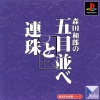Go ("weiqi" in Chinese, "baduk" in Korean), is an ancient board game for two players that originated in China more than 2,000 years ago. The game is noted for being rich in strategy despite its relatively simple rules (see Rules of Go).
The game is played by two players who alternately place black and white stones on the vacant intersections (called "points") of a grid of 19×19 lines. Once placed on the board, stones cannot be moved. If they are surrounded by the opponent's stones, they are captured and removed from the board. The object of the game is to surround a larger portion of the board than the opponent. When a game concludes, the controlled points (territory) are counted along with captured stones or your own stones (depending on the rule-set) and a predetermined compensation ("komi") to determine who has more points. Games may also be won by resignation.
Placing stones close together usually helps them support each other and avoid capture, while placing stones far apart creates influence across more of the board. Part of the strategic difficulty of the game stems from finding a balance between these types of conflicting interests. Players strive to serve both defensive and offensive purposes and choose between tactical urgency and strategic plans. At its basis, the game is one of simple logic, while in advanced play the game involves complex heuristics and tactical analysis. Beginning players first learn the simple mechanics of how stones interact, while intermediate students learn concepts such as initiative ("sente"), influence, and the proper timing of moves.
Go originated in ancient China sometime before the 3rd century BC (exactly when is unknown), by which time it was already a popular pastime, as indicated by a reference to the game in the Analects of Confucius. Archaeological evidence shows that the early game was played on a board with a 17×17 grid, but by the time that the game spread to Korea and Japan in about the 5th and 7th centuries respectively, the boards with a 19×19 grid had become standard.
Morita Kazuro no Gomoku Narabe to Renju is a igo game that features 3 different boards, pieces and backgrounds, and also a 2 players vs mode. The game is endorsed by japanese shogi & chess player Morita Kazuro and features commentary, advices, rules explanation.
Manufacturer's description:
Arrange five stones vertically and horizontally. Both Gomoku and Renju, rule is extremely simple! In addition, sharp deployment opponents have many short-term decisive battles and can be enjoyed easily anytime. You can choose the level of Morita thought from several stages, 2P opponent is possible. The game result is saved in the memory card as a score, furthermore the rule commentary and the environment setting etc are also substantial. It is also possible to save the progress of the game to the memory card and resume at a later date.
Features:
- First person perspective.
- 2D graphics
- Cartoon graphics
- Igo theme.
|
|














 - Disc Cover
- Disc Cover